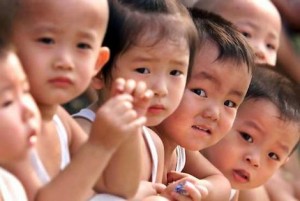 [1]With its announcement of possible reforms, China has implicitly admitted its forty year-old one child per-family policy has been a failure.
[1]With its announcement of possible reforms, China has implicitly admitted its forty year-old one child per-family policy has been a failure.
The rules led to draconian abuses. There were an estimated 336 million abortions, including forced abortions and sterilizations at the hands of a powerful and intrusive family planning establishment controlling the most intimate aspects of Chinese life. A rising callousness toward children and family has been attributed to the policy. Each year thousands of children are abandoned, and thousands more thought to be kidnapped and sold. So many abandoned babies die that the government set up “cottages” where parents can leave their children, mostly baby girls. On Wednesday, Time magazine reported [2] police arrested traffickers of 10 children only to find out their parents didn’t want their children back. The parents had sold them to the gang for much-needed cash.
China’s largest news agency, Xinhua, reported a proposed change to the highly unpopular policy in August, speculation confirmed by government officials. The current policy restricts couples in most of the country to get permission for a second child only if neither has a sibling. In the future, only one parent would have to be an only child to qualify. After two years, the whole country would shift to a two-child policy, reports say.
A recent Deutsche Bank report projected the new plan may lead to a baby boom, but would be too little too late to avert economic crises such as the country’s massive pension deficit. The report projected an increase in the nation’s fertility rate from 1.45 to 1.66 children per woman, with the biggest change seen in urban areas, where the policy is the strictest today, from 1.18 to 1.51. Rural areas could rise from 1.77 to 1.86 by 2018. Even so, the increases would be well below the replacement rate, about 2.1 children per woman. A reduction in the pension deficit would only be about 4% by 2040 at the earliest, the report said.The change is attributed to the receding influence of the old guard and some bureaucratic reform within the Chinese family planning establishment. The main driver, most agree, is Beijing’s recognition of a looming demographic crisis owing to precipitous fertility decline.
Since the one child policy’s inception in 1971, Chinese leaders along with UN experts and top demographers justified it by saying fewer people would make the Chinese people more prosperous. But fertility decline has led to a shrinking of the workforce five to six years earlier than experts projected. The contraction began in 2010 when the workforce peaked at 150 million. A shortage of 3 million workers was reported in 2012, and a 140 million worker-shortfall is predicted by the 2030s.
Making matters worse, China’s relative decline [3] in labor is steeper than even the bleak numbers suggest. The latest round of UN population projections show China aging faster than the UN previously predicted. Meanwhile its major competitors, the US and India, will see increases in workforce size due to a continuation of their near replacement fertility rates through 2100.
In the selected cities where Chinese officials launched the new rules, couples have not responded by having more than one child. This indicates norms have shifted toward very small families. National surveys indicate 40-50 percent of couples would like 2 children. But most were conducted before the economy soured. Rising costs of living and its fallout, such as separations to look for work, as well as rising infertility due to pollution and poor living conditions are blamed. The government announced this week it would fund a study to investigate the cause of infertility in 40 million Chinese women, according to the Chinese news portal Caixin.
Even if couples respond to the policy change with two-child families, there is little indication they would be relieved of the intrusive eyes – and enforcement mechanisms – of family planning officials. Along with forced abortions and sterilizations, officials collect steep fines for unauthorized children that amount to two to ten times a couple’s annual income. The government reportedly took in more than $2 billion in fines in 2012.